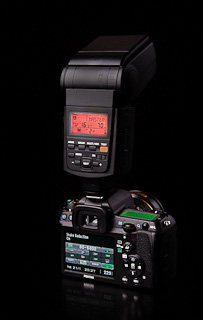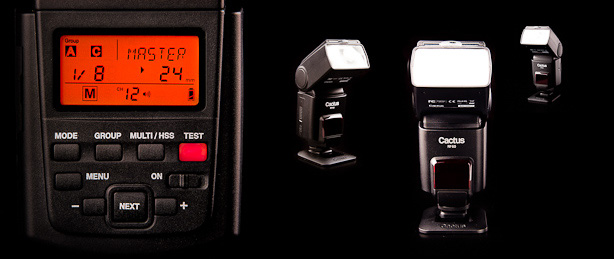Cactus RF60 Review
Operating Modes
The RF60 supports three main modes (Manual, Slave, Master) that one can cycle through by pressing the “MODE” button.
Local Mode
 |
| Local Mode Full manual control for predictability and consistency. |
Often labelled “Manual” on other flashes, this mode is meant for on-camera use, 3.5mm sync port triggering, or optical triggering. Cactus opted to use the “M” abbreviation for the “Master” mode and hence needed another moniker for this basic mode of operation.
Power levels and the zoom settings can be changed very quickly by just pressing the “-“ and “+” buttons. The “Next” button toggles between adjusting power and zoom settings and a cursor indicates the current selection to which the adjustment will apply. Adjustments are thus much quicker to make than on both Metz 58 AF-2 and Canon 540EZ, the two flashes I had available for direct comparison.
I like in particular that the RF60 can adjust the zoom setting up and down. Many other flashes use a single button that cycles through all settings which means that if one wants to adjust down or overran a setting, one always has to step through almost all zoom settings. The latter is not only time consuming but also reduces battery life as the zoom motor is exercised through almost all levels. Not so on the RF60.
Slave Mode
Slave mode adds radio triggering as a further triggering option. As a result, the menu now contains an additional item for configuring the radio channel (1—16) and the “GROUP” button now cycles through groups “A”—“D” thus allowing to assign the flash to one of four groups. It is possible to assign one out of nine aliases such as “Key”, “Fill”, “Rim”, etc. to the group letters in order to make it easier to remember what purpose a particular group serves. The RF60 always displays the group letter in the “Group” area and either repeats it in the text area on the top right or displays the assigned group alias instead.
Master Mode
The RF60 can control other RF60 or V5/V6 receivers in its Master mode.
 |
| Master mode An on-camera RF60 can contribute to the exposure and/or control up to four groups of external RF60 (or V6-triggered flashes). |
Using an intuitive interface, one can control the power levels and even zoom settings of up to four groups. Any group can contain an arbitrary number of flashes which will then all share the same parameters. Group parameters (power level and/or zoom settings) can be changed for individual groups or for all groups at the same time. In the latter case, changes are relative, for instance, the power level for all groups can be raised by one stop.
An RF60 master may contribute to the exposure with its own independent settings or just act as a controller, depending on whether the “MASTER” power is set to “OFF” or any level between “1/128” and “1/1”.
Personally, I believe it is preferable to use a smaller and much lighter V6 as an on-camera controller but if one wants to use an on-camera flash anyhow – for instance to provide fill light or as a bounce flash – then the RF60’s “Master” mode is a great means to control other flashes as well. The RF60’s “Master” mode is furthermore the only means to remote control the zoom settings of other flashes, since the V6 can only control power levels.
EDIT: It turns out that the Cactus V6 can also remotely control zoom settings of RF60s.


